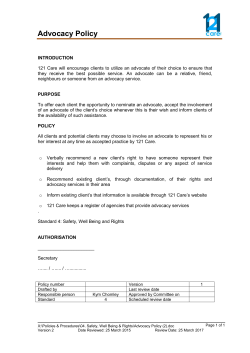
setting up a stress management program
s e t t i n g up a s t r e s s ma na g e me nt p r ogr am A CHECKLIST F OR s u ccess QTM Solutions Pvt. Ltd. www.qtm.co.in www.qtmglobal.com +91-96865 22932 BLR CHN DEL GUR HYD PUNE About this checklist This publication provides a step-by-step guide to initiate a business strategy to help employees better manage stress and reduce healthcare costs. No matter if your investment is relatively simple or more substantial, the key to success is to have long-range strategies customized to your employee population and that include both organizational and individual approaches. Following these strategies can help reduce absenteeism, turnover, improve productivity, and help employees better balance work/life issues. About Health Advocate™, Inc. Health Advocate, Inc., the nation’s leading independent healthcare advocacy and assistance company, serves more than 5,000 clients nationwide, providing more than 15 million Americans with personalized help to resolve healthcare and insurance-related issues. The company offers a spectrum of advocacy, Wellness, Pricing Decision Support and Human Resources solutions to help save time and money. The company also offers a direct-to-consumer advocacy service, called Health Proponent ®, to individuals who are not part of groups. www.qtm.co.in For more information, contact Health Advocate (toll-free) at: 1-866-385-8033, prompt #2 or via email at www.qtmglobal.com info@HealthAdvocate.com. T setting up a s t re s s ma na g e me nt p r og r a m a checklist for success he price of stress in the workplace has moved to the forefront of concern for businesses. Stressed workers are fatigued, prone to mistakes and injuries and more likely to be absent. Moreover, even when stressed workers come to work, they do not function up to par. Most startlingly, stressed employees incur healthcare costs nearly twice as high than for other employees. All tolled, the cost of stressed employees to businesses is estimated to be between $200 and $300 billion dollars a year. The causes of stress stem from both on-the-job and off-thejob factors. Long hours, heavy workloads and uncertain job responsibilities are compounded by work/life balance issues and worries stemming from the downturned economy, such as job security and loss of income. Experts warn that if companies do not address these stressors wherever possible, they may pay for it later. Workers who are stressed today can become ill tomorrow, driving up healthcare costs further. The encouraging news is that stress can be managed with a synergistic approach addressing both organizational changes and individual-based stress management strategies that teach employees to mitigate stress. Investments can range from the simple to the more substantial. Whatever approaches are used, a well thought-out stress management strategy should be a component of a companywide wellness program aimed at all workers, include multiple approaches and be customized to the needs and resources of the organization. The following strategies can help improve productivity and lower costs. Start with Assessment Look at the figures. The scope of stress may be uncovered by evaluating absenteeism, illness, turnover rates and performance. Form a stress management team. Representatives from management on down can help identify stressors such as long work hours. They can also determine if these factors are company-wide or specific to certain departments. Survey all employees. Hold discussions and/or design a survey to assess the stressors that employees face both on-the-job and off. Offer a Health Risk Assessment (HRA). This online or print questionnaire can help identify risks for diseases and contributing lifestyle factors, including stress levels. The HRA can help spur employees to take steps to reduce or manage their stress. Encourage Maximum Participation Do not single out employees who may be stressed. The goal is to foster well-being for all employees. Encouraging companywide participation in wellness is acceptable. However, singling out individuals for participating in stress management, weight loss or other specific components is not acceptable and is illegal, according to the Department of Labor and the Health Insurance Portability and Accountability Act (HIPAA) guidelines. Implement an incentives system. Incentives can help double participation in wellness programs, studies show. To be effective, incentives must be ongoing, offered at different intervals and tied to the specific activity. For example, employees could be awarded insurance premium rebates for taking a Health Risk Assessment (HRA). Or, offering a gift card for a massage could be an incentive for participation in a stress management workshop. Distribute ongoing communications. Posters, meetings, newsletters and the company intranet all boost awareness of stress management programs. Apply Organizational Strategies Here are some organizational changes that can help balance demand and control, and result in reduced stress levels: Structure jobs with meaning and opportunity for growth. Clearly define workers’ roles and responsibilities. Ensure that workloads are in line with workers’ capabilities and resources. Create a collaborative work environment. Making employees part of the decision-making fosters a sense of control. Provide opportunities for social interaction. Employees are less stressed when given the opportunity to socialize with coworkers, research shows. Options range from the simple, such as the use of games and contests, to the more involved such as company retreats with a menu of social activities. 2 Health Advocate, Inc. Offer Employee Assistance Programs (EAPs). EAPs, typically offered by the Human Resources department as part of the benefits, can help employees find professional help with work and/or personal issues. EAPs can lead to a decrease in worker’s compensation claims, absenteeism and employer healthcare costs. Consider changes in environmental design. Stress reduction solutions can include: natural lighting, noise-masking materials, ergonomically designed work stations and a designated “quiet” room to relax and recharge. Offer Multiple Approaches Enlist community organizations. Local groups such as the YMCA may provide on-site yoga instructors for instance. Mental health centers may offer experts to hold seminars on stress and coping strategies. Encourage exercise both on-site and off-the-job. Research shows that built-in exercise breaks at work, such as a 10-minute walk, may reduce employee stress and increase productivity. Set up support groups. Enlist a facilitator from Human Resources or from an outside source to keep discussions on the subject and focused on solutions. Think out of the box. Innovative stress management approaches may include in-house art programs, concierge services that provide dry cleaning services and grocery delivery, or wall screens depicting tranquil nature scenes in windowless offices. Institute Work/Life Balance Strategies Give employees flex time. Varying the time when employees arrive or leave work has been shown to reduce stress, especially for employees who are parents, caregivers or have a long commute. Offer job-sharing, part-time schedules and voluntary reduced work time. Employees have more time for outside responsibilities and companies save money. Allow work at home. This option has been shown to result in higher morale and to lower stress and turnover. Extend the lunch hour. A longer lunch time can provide an opportunity for exercise, relaxation or time for errands. Install child care initiatives. Options can include offering vouchers or subsidies that reduce costs for child care services; information about and referral to child care services; and on-site child care facilities. Companies can also reserve slots at local day care centers. Offer sick child care. Contract with a local hospital to provide child care for employees’ sick children. Health Advocate, Inc. 3 Address eldercare. Ideas include: geriatric specialists to address age-related concerns, workshop education initiatives, support groups centering on senior issues and extended leaves of absences. Invest in healthcare advocacy. A health advocacy service offers employees personalized help to resolve a range of timeconsuming healthcare issues, such as interacting with insurance companies and providers, resolving medical bills and help locating caregiving resources. Implement a return-to-work program. Structuring work with less responsibility can help the transition after an extended absence for illness or a family obligation. Encourage Individual Stress Management Supply easy-to-read information. Provide educational tip sheets and flyers about stress, its causes and reduction strategies. Give employees access to stress-reducing activities. Provide encouragement, time and space for yoga or other stress management activities. Enlist professional stress management coaches. Wellness coaches or special counselors can work one-on-one with individuals or groups of employees with similar stress issues. Consider mindfulness training. Mindfulness can be a relatively easy-to-perform and effective strategy. It helps employees focus their attention on the present moment, and involves stress-reducing techniques such as meditation and deep breathing, exercise and cognitive behavioral approaches. Provide employees with materials on mindfulness, hire a trainer and set up a quiet room for practice. Evaluate Success of Programs Evaluation begins with looking at figures relating to absenteeism, disability, presenteeism, productivity, turnover, workers’ compensation and use of medical care. Track participation rates. Count the number of employee participants after specific periods of time, such as two months, six months or a year. Compare the participation against the cost of incentives. If there is a high drop-out rate among employees, perhaps goals are set too high or the incentives offered do not kick in early enough. Compare Health Risk Assessment results before and after program participation. This can help gauge the effectiveness of your stress reduction strategies. 4 Health Advocate, Inc. “The key to successfully managing workplace stress rests on addressing both organizational changes and individual-based stress management.” QTM Solutions Pvt. Ltd. (Working towards "People Excellence & Development") www.qtm.co.in www.qtmglobal.com +91- 96865 22932 Bangalore Chennai Delhi Gurgaon Hyderabad Pune kapil@qtm.co.in 1-866-385-8033 (toll-free) info@HealthAdvocate.com www.HealthAdvocate.com ©2009 Health Advocate, Inc. W-B-SWCL0809 Independent. Confidential. Convenient. Health Advocate is not affiliated with any insurance or third party provider. Health Advocate does not replace health insurance coverage, provide medical care or recommend treatment.
© Copyright 2025





















